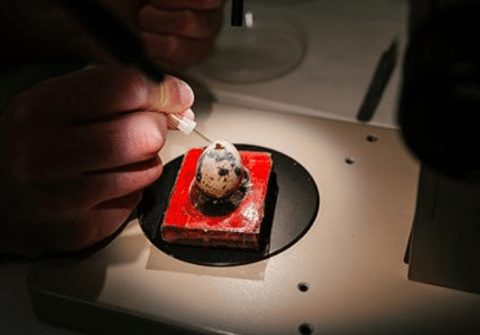Introducing the Monash Transgenic Quail Facility
Globally, there are only three research institutes that have a dedicated quail facility, with the Australian Regenerative Medicine Institute (ARMI) at Monash University being one of them. ‘ARMI and Monash University have been leaders in founding and supporting this facility,’ said ARMI researcher and head of the facility, Dr Olivier Serralbo. The Frenchman, who has worked with Drosophila, plant and mouse models throughout his 18-year research career, now runs the Monash Transgenic Quail Facility (MTQF) full-time.
Completed in 2017, the MTQF is a joint intiative between Professor Christophe Marcelle and Dr Olivier Serralbo. MTQF is unique and ground-breaking as it breeds transgenic Japanese quail lines, which play an important role in a plethora of scientific research fields. ‘Quails are a fantastic animal model to study embryology and skeletal muscle development,’ says Olivier. ‘The development of the skeletal system is evolutionarily conserved between quail and humans, so any discoveries you make in the quail system typically translate into humans.’ Their use in studying skeletal muscle development can help further our understanding of the underlying causes and the development of muscle disorders, critical signalling pathways involved in diseases such as cancer, and ultimately, how we can harness specific molecular pathways in regenerative medicine.

The research world has been slow to adopt the quail as a transgenic animal model, due to the outdated method of genetic manipulation available. ‘We wanted to avoid using lentivirus. It’s not very reliable and efficient in this situation,’ explains Olivier. In collaboration with scientists from the CSIRO, Olivier has been able to establish more effective ways to modify the genes in the quail model. Using the Tol2 genome integration system, Olivier has produced seven transgenic lines thus far. Now, he is experimenting with using the revolutionary CRISPR/Cas9 system of genome editing. With the Marcelle group at ARMI leading the way in using the quail model, Olivier is confident more research groups will begin to realise its advantages and benefits.
‘There are many advantages to the quail model. Their genome has been sequenced. They’re an efficient model, taking 6-7 weeks to become sexually mature. They lay many eggs a week, which can be stored at 15 degrees until they are needed,’ says Olivier. One of greatest advantages of using the quail is the accessibility to the embryo, due to its development in a shell. With this, there is the ability not only to perform genetic manipulation, but also the range of protocols common to avian models, such as cell grafting.
12 hours in ovo time lapse imaging of Transgenic quail embryo Tg(Caggs-nlsmCherry). Dorsal view of the neural tube and somites. Confocal SP8, 20x lens.
Olivier is currently in the process of some pioneering work, optimising breeding and imaging techniques. Notably, he has transformed the process of genotyping, with a GFP-tagged construct that is expressed in the lens of the eye only when the process of genetic manipulation has been successful. ‘This means you don’t have to go through the genotyping process. This is much quicker.’
‘The imaging possibilities are the greatest strength of this model. There are capabilities to have different cell populations fluoresce different colours. You’re able to see which signalling pathways are activated under the microscope, and you can even turn on gene editing with light,’ explains Olivier. At this very moment, Olivier is developing and refining live-imaging techniques and high-resolution cell tracking for the model.

The quail is not only a powerful animal model for use in the academic setting. Sharing 95% of its genome with the chicken, the poultry industry can also benefit from using the quail, particularly in investigating infectious diseases that can strike chickens, crippling the industry.
‘We hope to make the MTQF as THE quail facility. We can produce transgenic quails for both research and industry. Eggs can be shipped nationally and globally. We can share the knowledge we have gained and the techniques we have developed,’ Olivier says. This facility joins AquaCore, which houses sharks, zebrafish and axolotls, making ARMI a comprehensive regenerative medicine research institute. Undoubtedly, the quail model is powerful, versatile and is capable of facilitating an unprecedented level of accuracy, precision and control and a model that all regenerative medicine researchers should consider.
Transgenic quail embryo after 12h in ovo time lapse acquisition.
For more information on the MTQF, please visit the ARMI Facilities page. You can contact Dr Olivier Serralbo via olivier.serralbo@monash.edu.
